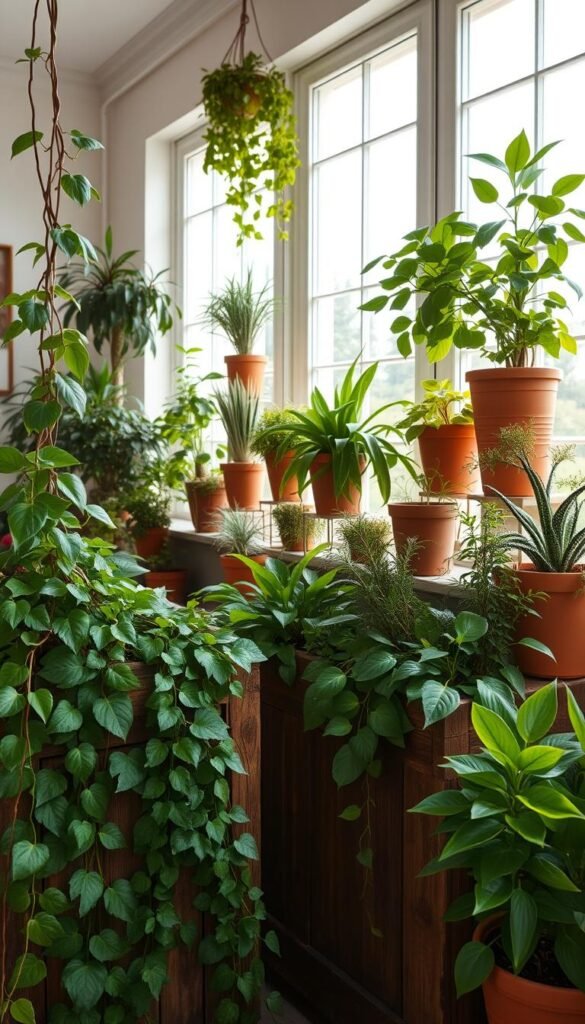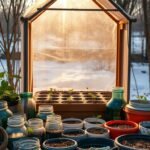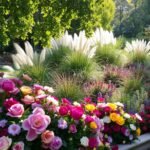Transform your living space into a thriving green sanctuary through clever plant arrangements. By grouping greenery in shallow containers, you can achieve professional-quality designs that maximize visual impact. This approach mirrors outdoor colorful container gardening principles while adapting them for home environments.
Successful displays rely on three-dimensional composition. Taller specimens act as focal points, mid-height varieties fill gaps, and trailing types soften edges. This thriller-filler-spiller method creates depth that makes any grouping appear fuller than individual potted greenery.
Texture contrast proves essential for eye-catching results. Pair broad-leafed varieties with feathery ferns or spiky succulents. Vary color tones using burgundy-edged leaves alongside silver-speckled types. These combinations produce dynamic arrangements that look curated by design experts.
Remember to match your selections to available light and humidity levels. When properly coordinated, your layered arrangement will thrive while creating an organic, museum-worthy showcase. Even limited spaces can host impressive botanical displays through thoughtful spatial planning.
Why Layering Plants Transforms Your Indoor Garden
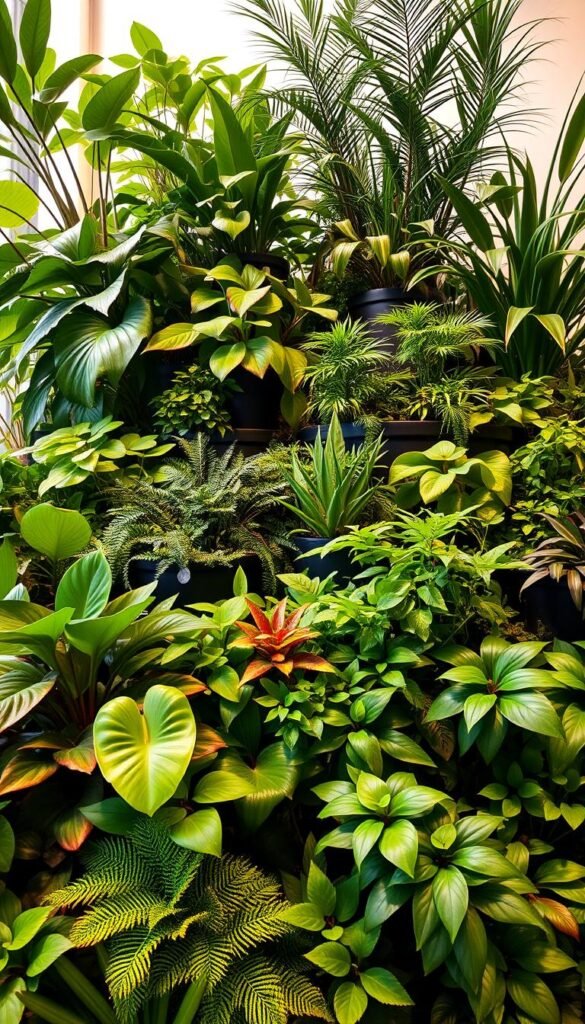
Elevating your greenery through vertical arrangements does more than save space. Research shows strategic plant placement boosts mood and air quality while creating dynamic focal points. A 2015 study found interacting with layered arrangements reduces stress markers by 37% compared to single-pot displays.
Benefits of Layered Planting
Three-dimensional compositions work magic in tight spaces. Taller specimens like snake plants draw eyes upward, while trailing pothos soften planter edges. This approach:
| Arrangement Type | Space Impact | Care Advantage |
|---|---|---|
| Single-Level | Flat appearance | Uneven watering |
| Multi-Tier | Depth illusion | Targeted light access |
| Cluster Grouping | Fuller look | Humidity sharing |
Mixing textures and heights mimics natural ecosystems. Your collection becomes a living sculpture that thrives through mutual support.
Enhancing Visual Impact with Multiple Foliage Levels
Play with scale using these pro techniques:
- Use height-diverse planters to create cascading effects
- Position light-loving varieties atop stacked containers
- Let trailing types spill over shelf edges
This method ensures each specimen gets ideal growing conditions while forming cohesive displays. You’ll notice how shadows from taller plants highlight delicate fern patterns below.
Essential Tools and Supplies for Your Dish Garden
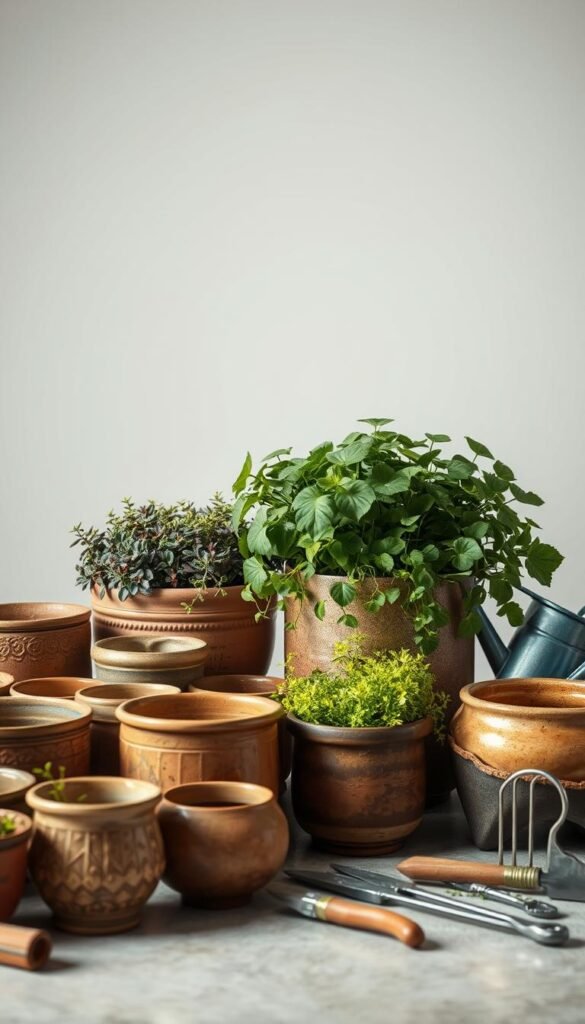
Crafting stunning plant arrangements begins with gathering the right tools. Four elements form the foundation: containers, drainage materials, greenery, and finishing touches. Each component works together to create healthy, eye-catching displays that thrive indoors.
Choosing the Right Containers and Drainage Materials
Select vessels that balance style and function. Waterproof options like ceramic trays or lined baskets prevent leaks on surfaces. If your planter has drainage holes, seal them with silicone and add a plastic liner for extra protection.
| Material | Best Use | Weight Consideration |
|---|---|---|
| Ceramic | Tabletop displays | Heavier; stable base |
| Glass | Modern aesthetics | Fragile; needs padding |
| Fiberglass | Wall-mounted setups | Lightweight; portable |
Layer 1-2 inches of drainage material at the container’s base. Pumice stones work well for lightweight setups, while decorative rocks add visual interest. These layers keep roots above pooled water, preventing rot.
Must-Have Accessories for Easy Maintenance
A long-spouted watering can lets you direct water precisely to each plant’s base. Pair it with moisture-retaining top dressings like moss or polished stones to reduce watering frequency.
Consider these maintenance essentials:
- Pruning shears for shaping overgrown stems
- Microfiber cloths for dusting leaves
- pH test strips for soil health checks
Choose planters that match your space’s aesthetic while allowing room for growth. Shallow containers (4-6″ depth) suit most arrangements, letting you showcase multiple textures without overcrowding.
Step-by-Step Guide to Assembling Your Indoor Dish Garden
Build your own botanical masterpiece using these pro techniques. Start by preparing your planter with a drainage layer of pebbles or clay pellets. This critical foundation prevents root rot while letting excess moisture escape.
Arranging Plants Strategically for Fullness
Position taller specimens like dracaena in the center. Work outward with medium-height varieties such as peperomia. Finish by tucking trailing ivy near the edges. Crowd them closer than usual – this creates instant lushness while hiding individual containers.
Keep greenery in their original pots for customized care. This smart approach lets you adjust watering schedules based on each plant’s needs. Rotate your arrangement weekly to ensure even light exposure.
Finishing Touches with Top Dressing and Décor
Conceal pot rims using sheet moss or decorative stones. These materials unify the display while reducing evaporation. Add personality with miniature garden ornaments between foliage clusters.
Water gently using a narrow-spout container. Target each plant’s base to prevent oversaturation. Check soil moisture every 5 days – most arrangements thrive with weekly hydration. Your finished creation becomes a living sculpture that evolves over time.
Maximizing Space with Indoor Garden Ideas for Limited Areas
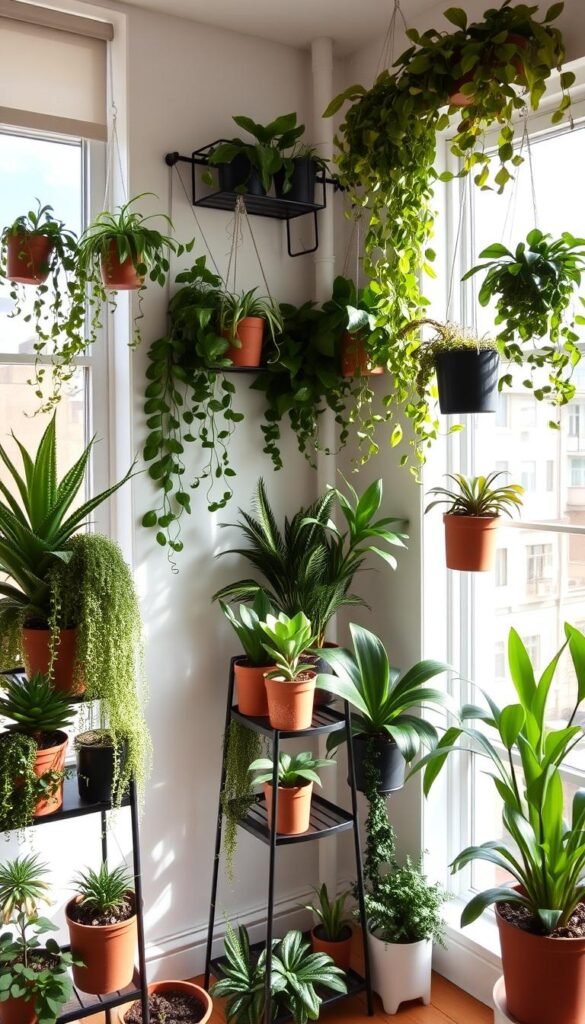
Unlock hidden potential in tight living areas through smart spatial solutions. Strategic placement turns underused nooks into thriving botanical zones. The secret lies in matching your greenery to architectural features and available surfaces.
Corner Solutions and Vertical Innovations
Square planters become space heroes in angular spots. Their sharp edges hug walls seamlessly, creating instant green corners. Try pairing them with triangular shelves that slot perfectly into tight junctions.
Vertical surfaces offer untapped growing real estate. Mounted planters transform blank walls into living art installations. Consider these space-efficient options:
| Vertical Solution | Space Saved | Ideal Plants |
|---|---|---|
| Wall pockets | 100% floor area | Air plants |
| Hanging baskets | Overhead zones | Trailing pothos |
| Corner shelves | Wasted angles | Compact succulents |
Lightweight fiberglass containers let you experiment freely. Move them between sunny windows and shaded bookcases as needed. One user reported, “Switching locations weekly helps my collection thrive in different light conditions.”
Multi-level shelving systems create depth without clutter. Stagger heights to showcase cascading vines above bushy foliage. This approach makes even narrow alcoves feel lush and intentional.
Remember: every surface holds potential. Windowsills host herb gardens, while bookshelves become mini jungles. Combine floor-standing specimens with elevated displays for 360° greenery that breathes life into cramped quarters.
Innovative Displays: Tabletop, Window, and Hanging Garden Concepts

Reimagine your home’s layout through three-dimensional greenery solutions that turn empty surfaces into botanical showcases. Vertical arrangements maximize every inch while adding artistic flair to functional spaces.
Creative Use of Vertical Space
Wall-mounted planters revolutionize blank surfaces with living art installations. Opt for geometric designs in lightweight fiberglass or repurposed wooden crates. These space-saving options let you curate mini ecosystems at eye level.
Hanging baskets introduce movement to static rooms. Try these height variations:
- Macramé holders dangling 18″ below ceilings
- Tiered metal frames showcasing cascading ferns
- Glass globes suspended at staggered levels
Window gardens serve dual purposes – filtering sunlight through ivy tendrils while boosting oxygen levels. Install tension rods with clip-on planters for temporary displays that won’t damage frames. One user shared: “My philodendron curtain makes mornings feel like a jungle sunrise.”
| Vertical Solution | Space Used | Maintenance Level |
|---|---|---|
| Magnetic planters | Appliance sides | Low |
| Pegboard systems | Office walls | Moderate |
| Ladder shelves | Room corners | Easy |
Trellis systems transform plain walls into climbing vine canvases. Train pothos or monstera along wire grids using soft plant ties. This living wallpaper grows thicker each season, naturally insulating rooms.
For renters, adhesive hooks and tension rods offer damage-free hanging options. Mix tabletop planters with elevated displays to create depth. Floating shelves become rotating galleries – swap succulents for flowering varieties as seasons change.
Small Indoor Garden Ideas: Layering Plants for a Full, Vibrant Display
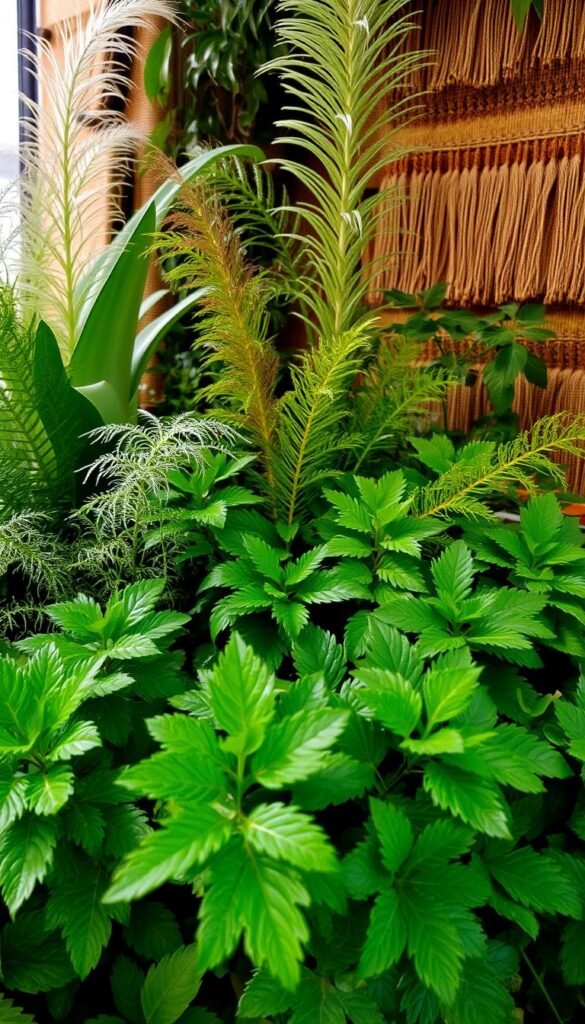
Craft dynamic displays by blending foliage dimensions and hues. The secret lies in balancing bold statement pieces with supporting cast members. Jewel alocasias steal the show with metallic leaves reaching 3 feet tall, thriving in humid corners.
Mastering Dimension Combinations
Blue star ferns add unexpected flair with their powder-coated fronds. Pair them with glossy philodendron leaves to create captivating contrasts. This technique works wonders in north-facing rooms with filtered light.
| Plant Variety | Height Range | Texture | Design Role |
|---|---|---|---|
| Jewel Alocasia | 12-36″ | Glossy metallic | Focal point |
| Blue Star Fern | 10-14″ | Powdery matte | Contrast element |
| Rattlesnake Plant | 12-30″ | Patterned ridges | Visual anchor |
| Peperomia | 6-12″ | Waxy smooth | Space filler |
Color coordination becomes effortless when using patterned specimens. Calathea’s snake-skin leaves pair beautifully with solid-colored neighbors. Try flanking them with purple oxalis for complementary tones.
Petite peperomias solve spacing challenges. Their compact forms bridge gaps between towering specimens and trailing vines. Cluster three varieties together for instant fullness without overcrowding.
Rotate flowering specimens seasonally to maintain interest. A single orchid elevates green-dominated arrangements, while kalanchoe blooms add months of color. Remember: odd numbers create natural-looking groupings.
Expert Tips for Watering, Plant Potting, and Ongoing Maintenance
Keep your layered greenery thriving with precision care techniques. Since plants stay in individual pots, you’ll want to check each one’s soil weekly. Indoor heating and sunlight can dry soil faster than expected – especially in winter or sunny spots.
Effective Techniques for Individual Plant Care
Test soil moisture by pressing your finger into the top inch of potting mix. For succulents, wait until the soil dries completely. Delicate varieties like calathea need filtered water to prevent leaf discoloration from tap water minerals.
| Plant Type | Watering Frequency | Water Type |
|---|---|---|
| Succulents | Every 3-4 weeks | Room temperature |
| Tropicals | Weekly | Filtered |
| Ferns | Twice weekly | Distilled |
Lift pots to gauge weight – light containers signal thirsty plants. Use narrow-spout watering cans for targeted hydration. This method prevents overwatering while reaching roots in tight arrangements.
Choose proper containers that match each plant’s needs. Shallow pots work well for clustered displays but dry faster. For seasonal adjustments, rotate plants to maintain even growth. Group moisture-loving varieties together to simplify care routines.
Modern Planter Options: From Fiberglass to Hand-Painted Ceramics
Elevate your home’s aesthetic with containers that blend form and function. Today’s best planters solve practical needs while expressing personal style. Designers now favor materials that adapt to evolving trends without sacrificing durability.
Trends and Design Ideas in Indoor Planter Styles
Fiberglass planters dominate modern gardening for good reason. Their featherlight build lets you rearrange displays effortlessly, while weather-resistant finishes work indoors and out. The Cuba Low Corner Planter slots perfectly into tight spaces, its tapered profile maximizing greenery in narrow areas.
Hand-painted ceramics add artistic flair to tabletops. Pair matte-finish pots with glossy-leaved specimens for striking contrasts. For sun-drenched spots, opt for UV-stable options that prevent color fading. Perth Tall Corner Planter’s vertical design draws eyes upward, ideal for trailing vines.
Mix materials to create visual interest. Try these combinations:
- Textured terracotta bowls with sleek metal stands
- Glass vessels showcasing intricate root systems
- Lined baskets offering rustic charm
Current trends favor multifunctional pieces. Footed planters double as sculptural elements, while antique-inspired ice buckets introduce vintage character. Whatever your choice, ensure proper drainage and scale – smaller pots suit compact houseplants, letting you build layered arrangements over time.

